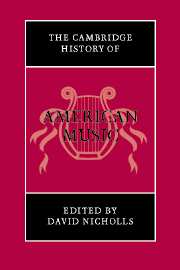Book contents
- Frontmatter
- PART ONE
- 1 American Indian musics, past and present
- 2 Music in America: an overview (part 1)
- 3 Secular music to 1800
- 4 Sacred music to 1800
- 5 African American music to 1900
- 6 Immigrant, folk, and regional musics in the nineteenth century
- 7 Nineteenth-century popular music
- 8 Art music from 1800 to 1860
- 9 Art music from 1860 to 1920
- PART TWO
- Bibliography and references
- Index
- References
4 - Sacred music to 1800
from PART ONE
Published online by Cambridge University Press: 28 March 2008
- Frontmatter
- PART ONE
- 1 American Indian musics, past and present
- 2 Music in America: an overview (part 1)
- 3 Secular music to 1800
- 4 Sacred music to 1800
- 5 African American music to 1900
- 6 Immigrant, folk, and regional musics in the nineteenth century
- 7 Nineteenth-century popular music
- 8 Art music from 1800 to 1860
- 9 Art music from 1860 to 1920
- PART TWO
- Bibliography and references
- Index
- References
Summary
As with any music before the age of sound recording, what survives of pre-nineteenth-century American sacred music is that which was written down or published. This means, in the main, Anglo-American Protestant psalmody. Psalmody - the word here referring to musical settings not only of the Biblical psalms but also of hymn texts and Biblical prose – was an extraordinarily rich creative phenomenon in late-eighteenth-century America. The vast literature of this tradition and the high artistic quality of many of its compositions are substantially the reasons why a separate chapter on early American sacred music is found in the present volume.
It is important, however, to consider the tradition of Protestant psalmody within a larger context: that of music as an aspect of worship - or, more broadly stated, of sacred activity. Humans have used music in various ways to express, intensify, channel, or unblock their relationship to the divine. Music can bring a person closer to God or to the spiritual realm; it can also create and strengthen the bonds within a community of worshippers or spiritual seekers. In different ritual settings within different cultural traditions, religious music has worked in very different ways: intensifying consciousness or dissolving it; exciting the body and spirit or rendering them tranquil; reinforcing established social hierarchies or providing a temporary alternative.
Seen from these perspectives, Protestant worship music occupies a very particular place in a wide spectrum of traditions. Both German Protestantism and the mainstream of Anglo-American Protestantism have always been wary of departing from consciousness and rationality in worship. And they have rarely encouraged individual or personal religious experiences.
- Type
- Chapter
- Information
- The Cambridge History of American Music , pp. 78 - 102Publisher: Cambridge University PressPrint publication year: 1998
References
- 1
- Cited by

